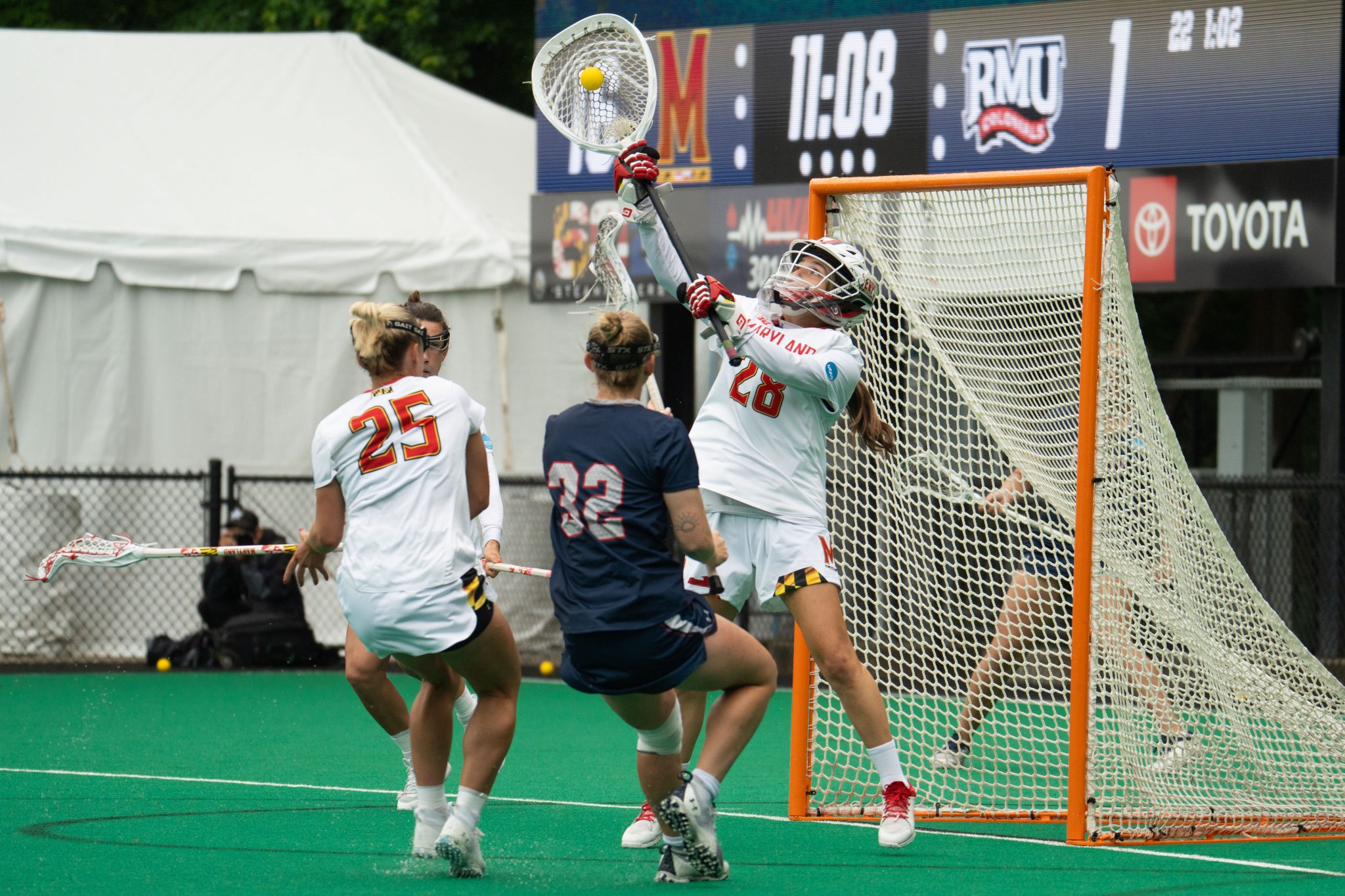Maryland women’s lacrosse goalie Julia Hammerschlag had only appeared in seven games in a Terps uniform entering the NCAA tournament. The Baltimore native began her career at Florida and returned to her home school for the past two seasons.
Maryland’s usual starting goalie Emily Sterling — a second team All-Big Ten honoree and Tewaaraton Award nominee — didn’t play due to a coach’s decision. It didn’t matter.
Hammerschlag made a career-high six saves as the fourth-seeded Terps used a suffocating defensive effort to advance past Robert Morris, 17-1, in the first round of the NCAA tournament on Friday at the Maryland Field Hockey and Lacrosse Complex.
“She hasn’t had too many opportunities this year to get out there,” coach Cathy Reese said. “We’ve spent a lot of time this week talking about doing your job, and when your name is called, be ready to step up. … she did her job and stepped up and rose to the challenge.”
The Terps will face the winner of Penn State and James Madison in the second round on Sunday.
Maryland (13-5) advanced to the second round of the national tournament for the 17th straight time the event has been held, a run dating back to the 2006 season. The tournament wasn’t held in 2020 due to the COVID-19 pandemic.
[Maryland women’s lacrosse’s accomplished graduate students seek one last feat]
Robert Morris’ (8-12) attack ranks inside the bottom 10 among all Division I schools in scoring. The Colonials average under nine goals per game and only eclipsed 10 goals in nine of their 19 games leading into the tournament.
But the unit guided them into the NCAA tournament as the only team with a losing record. Robert Morris won five straight contests to win the Mid-American Conference tournament and earn an automatic bid to the NCAA tournament, scoring just under 14 goals a game over those five outings.
The Colonials, facing improved competition, only managed one goal in the entire game — scored from attacker Jenna Irwin on a free position opportunity. That was due to Maryland’s stifling defense.
The Terps’ defensive unit was stalwart entering their matchup with Robert Morris. They allowed an average of under nine goals per game, only 150 conceded over 17 pre-NCAA tournament games.
The unit excelled despite the absence of Sterling.
Hammerschlag warded off two shots in the opening period to keep the Colonials scoreless until the 13-minute mark of the second quarter. She made two more saves to bring her total to four at halftime, adding two more after the break.
The Maryland defense caused five turnovers to contribute to Robert Morris’ 15 total.
[Chrissy Thomas’ emergence has deepened Maryland women’s lacrosse’s attack]
The Terps conceded just a single goal for the first time since the 2019 season. Maryland won the national championship that year.
Midfielder Shaylan Ahearn dominated inside the midfield circle on the draw control. The Terps won the first six draws — all in the first quarter — to propel them into an early lead they didn’t relinquish. The Terps finished the contest with 16 wins at the circle.
Maryland scored the game’s first five goals. Attacker Eloise Clevenger scored twice and midfielder Kori Edmondson tallied her 30th of the season to headline the early onslaught.
“We were feeding off of the defense’s energy,” Edmondson said. “Julia was making great saves in there. So that just carried over to the offense.”
Eight different goalscorers added their names to the scoresheet in the 16-goal win.
Edmondson and attackers Hannah Leubecker and Kate Sites all recorded hat tricks. Leubecker’s three goals put her at 50 scores this year — a team high. Sites’ four goals led all scorers.
Attackers Hailey Russo, Lauren LaPointe, and Maggie Weisman, along with midfielder Shannon Smith, tallied at least one goal to aid the balanced attack.
“Everyone really stepped up,” Reese said. “It just made it feel like it was really combined, and really one successful unit.”
Maryland’s defense limited Robert Morris’ offensive output, but its attack flourished in its opening round NCAA tournament game. The Terps took advantage of their abundant opportunities, converting 45 percent of their shots. They will need to continue that trend to make the quarterfinals for the first time since 2021.



